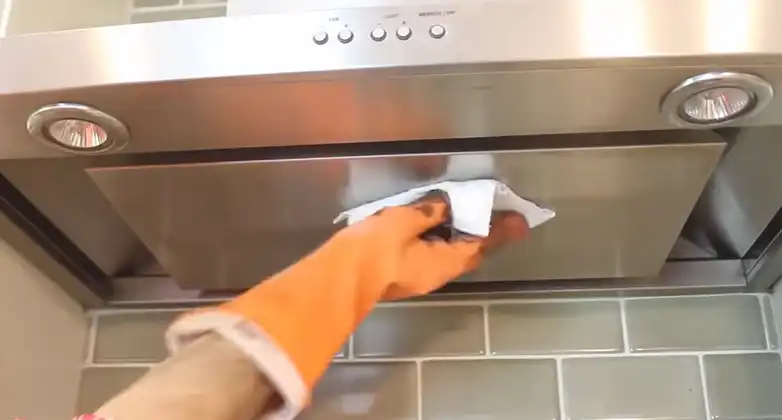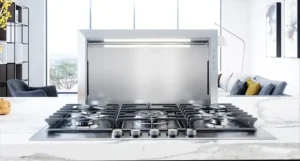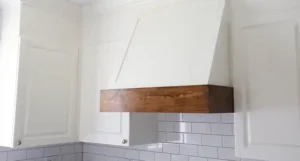Range hoods are the reason why your kitchen isn’t that sticky. That means it sucks in a lot of oil, grease and smoke. Over time, this accumulated grease and oil can make the whole thing sticky. So, it’s important to learn how to clean a sticky range hood, which we are going to explain in this article.
To clean a sticky range hood, use a mixture of dish soap and warm water to break down grease and grime, then wipe it clean with a cloth.
We’ll also cover how to determine if it needs cleaning, the benefits of keeping it spick and span, and throw in some FAQs to address your burning questions. So, roll up your sleeves, put on your cleaning apron, and let’s dive into the world of range hood cleaning.

How to Do It: Step-by-Step Range Hood Cleaning
Here’s a step-by-step guide on how to clean a range hood to get rid of that sticky grease:
Step 1: Safety First
Before you embark on your range hood cleaning journey, ensure your safety. Here’s what you need:
Gloves: Protect your hands from any chemicals or grease.
Eye protection: Safety goggles are your best friend when it comes to preventing splashes in your eyes.
Ventilation: Turn on your kitchen exhaust fan or open a window to maintain good airflow.
Materials: You’ll need some household items like warm water, dish soap, a bucket, a sponge, a scrub brush, microfiber cloths, and a screwdriver (in case you need to remove the filter).
Step 2: Check Your Range Hood’s Condition
Before diving into cleaning mode, assess the state of your range hood. Some key indicators that it needs cleaning include:
Visible grease buildup: If you can see thick layers of grease clinging to the hood, it’s time to clean.
Unpleasant odors: Lingering cooking smells that just won’t go away often mean your filters are clogged with grease.
Decreased effectiveness: If your range hood seems less efficient at removing steam or smoke while you cook, it’s a clear sign that it’s due for a cleaning.
Step 3: Remove the Filters
If your range hood has filters, these are typically the dirtiest parts and should be cleaned regularly. Here’s how to remove them:
- Turn off the range hood and wait for it to cool down if you’ve been cooking recently.
- Depending on your range hood model, you may need to open the hood to access the filters. Use a screwdriver if necessary.
- Carefully remove the filters from their slots. These can usually be pulled out or unlatched.
Step 4: Soak the Filters
Now that you’ve got your filters in hand, it’s time to give them a good soak. Fill a bucket or sink with hot water and add a few drops of dish soap.
- Submerge the filters in the soapy water.
- Let them soak for at least 15-30 minutes. This will help to loosen the grease and grime.
Step 5: Scrub Away the Grease
Once your filters have had a good soak, it’s time to get scrubbing. Use a sponge or a scrub brush to gently scrub away the grease and dirt.
- Hold the filter securely, and scrub both sides thoroughly.
- Pay extra attention to any stubborn spots. A little extra elbow grease here can go a long way.
- Rinse the filters with warm water to remove any soap residue.
Step 6: Dry and Reinstall the Filters
After giving your filters a good scrubbing, it’s time to let them dry completely before reinstalling them.
- Place the filters on a clean towel or paper towel to air dry. Make sure they are completely dry to prevent mold growth.
- Once dry, put the filters back into their slots in the range hood.
Step 7: Clean the Exterior
Now that the filters are clean and back in place, it’s time to tackle the exterior of your range hood. Here’s how:
- Mix a solution of warm water and a few drops of dish soap in a bucket.
- Dip a microfiber cloth or sponge into the soapy water, wring it out so it’s not dripping, and wipe down the exterior surfaces of the range hood.
- Pay special attention to any sticky or greasy spots. You may need to apply a little extra pressure to remove stubborn grime.
- Rinse the cloth or sponge frequently in the soapy water and continue wiping until the entire exterior is clean.
- Finish by wiping down the hood with a clean, damp cloth to remove any soap residue.
- Dry the exterior with a clean, dry cloth to prevent water spots and streaks.
Step 8: Clean the Interior
Now, let’s not forget about the interior of the range hood. It’s where the magic happens! Here’s how to clean it:
- Dip a sponge or cloth into the soapy water.
- Carefully reach inside the hood and wipe down the interior surfaces, including the fan blades and any exposed metal or plastic parts.
- Use a scrub brush for any tough-to-reach or heavily soiled areas.
- Rinse the sponge or cloth frequently and keep wiping until the interior is clean.
- Finish by wiping down with a clean, damp cloth to remove soap residue.
- Dry the interior with a clean, dry cloth.
Step 9: Clean the Ventilation Ducts (if necessary)
If you have access to your range hood’s ventilation ducts, it’s a good idea to clean them periodically. However, this is a more involved process and may require professional assistance. Here’s a basic overview:
- Turn off the power to the range hood to ensure safety.
- Remove the duct covers if they are accessible.
- Use a vacuum cleaner with a long attachment to remove any loose debris or dust from the ducts.
- If needed, use a damp cloth or a specialized duct cleaning brush to scrub the interior of the ducts. Be cautious not to damage any ductwork.
- Reattach the duct covers and restore power to the range hood.
Step 10: Reassemble and Enjoy Your Clean Range Hood
Now that you’ve completed the cleaning process, it’s time to put everything back in its place. Reattach any parts you removed, such as the filters or duct covers. Turn on your range hood and bask in the glory of a clean and efficient kitchen appliance.
What Are the Benefits of Cleaning Your Range Hood?
Cleaning your range hood may seem like just another chore, but the benefits are well worth the effort. Let’s take a closer look at why you should keep your range hood in tip-top shape:
Improved Air Quality
A clean range hood does a better job of removing smoke, steam, and cooking odors from your kitchen. This means fresher air for you and your family to breathe while you cook and dine.
Enhanced Safety
Reduced grease buildup reduces the risk of fires in your kitchen. A clogged range hood can trap flammable grease, making it a fire hazard. Regular cleaning helps ensure your kitchen stays safe.
Better Efficiency
A clean range hood is more efficient at its job. It can effectively capture and vent out smoke and steam, making your cooking experience more pleasant and efficient.
Prolonged Lifespan
Regular maintenance and cleaning can extend the lifespan of your range hood. You’ll save money in the long run by avoiding costly repairs or replacements.
Aesthetic Appeal
A clean range hood contributes to the overall cleanliness and aesthetics of your kitchen. It’s one less eyesore to worry about.
Eco-Friendly
When your range hood is working efficiently, you’re not wasting energy on unnecessary fan power. This is not only good for your wallet but also for the environment.
Prevents Unpleasant Odors:
A range hood caked with grease can’t effectively remove cooking odors, leaving your kitchen smelling less than desirable. Regular cleaning keeps your kitchen smelling fresh.
Reduces Health Risks:
Grease buildup can attract pests like cockroaches and mice. Keeping your range hood clean reduces the risk of infestations.
People Also Ask
How often should I clean my range hood?
The frequency of cleaning your range hood depends on how often you cook and the types of dishes you prepare. In general, it’s a good idea to clean the filters and surfaces at least once a month. However, if you do a lot of deep-frying or use your range hood frequently, you may need to clean it more often.
Can I put range hood filters in the dishwasher?
It’s not recommended to put aluminum range hood filters in the dishwasher. The high heat and strong detergents used in dishwashers can damage the filters. Hand washing with warm, soapy water is the safer option.
Can I use any cleaning products on my range hood?
It’s best to stick with mild dish soap and warm water for cleaning the range hood and filters. Harsh chemicals can damage the finish and may be unsafe for surfaces that come into contact with food.
How do I clean a range hood with no removable filters?
If your range hood doesn’t have removable filters, you can still clean it. Follow the steps mentioned in this guide for cleaning the exterior and interior surfaces. Use a vacuum cleaner with a brush attachment to remove loose debris from the interior.
Is it safe to clean the ducts myself?
Cleaning the ducts can be a bit more complex and may require professional assistance, especially if they are hard to access. If you choose to do it yourself, make sure to turn off the power to the range hood and exercise caution to avoid damaging the ductwork.
Can I use vinegar to clean my range hood?
While vinegar is an excellent natural cleaner, it may not be the best choice for range hoods. The acidic nature of vinegar can damage certain materials and finishes. Stick to mild dish soap and warm water for safe and effective cleaning.
What if my range hood still smells after cleaning?
Lingering odors could be due to trapped grease or debris in the ductwork. Consider having the ducts professionally cleaned. Additionally, you can place a bowl of baking soda or activated charcoal inside the range hood to help absorb odors.
Can I use a steam cleaner to clean my range hood?
Steam cleaners can be effective for cleaning range hoods, especially for cutting through grease. However, check your range hood’s manufacturer guidelines to ensure that steam cleaning is safe for your specific model.
My range hood has rust spots. How can I remove them?
To remove rust spots, create a paste using baking soda and water. Apply the paste to the rust spots and gently scrub with a sponge or cloth. Rinse thoroughly and dry. For stubborn rust, you can use a rust remover, but be cautious and follow the product’s instructions carefully.
What’s the best way to maintain a clean range hood?
Regular cleaning is the key to maintaining a clean range hood. Develop a cleaning routine that includes wiping down the exterior and interior surfaces, as well as cleaning the filters. Additionally, be mindful of the types of cooking you do to prevent excessive grease buildup.
In Summary
Cleaning your range hood may not be the most glamorous task, but it’s essential for a safe and efficient kitchen. With the step-by-step guide we’ve provided, along with the benefits of keeping your range hood clean and the answers to common questions, you’ll be well-equipped to tackle this kitchen chore with confidence. So, go ahead, make your range hood shine, and enjoy a fresher, safer cooking environment!



